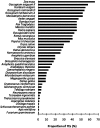A brief history of the status of transposable elements: from junk DNA to major players in evolution
- PMID: 21156958
- PMCID: PMC2998295
- DOI: 10.1534/genetics.110.124180
A brief history of the status of transposable elements: from junk DNA to major players in evolution
Abstract
The idea that some genetic factors are able to move around chromosomes emerged more than 60 years ago when Barbara McClintock first suggested that such elements existed and had a major role in controlling gene expression and that they also have had a major influence in reshaping genomes in evolution. It was many years, however, before the accumulation of data and theories showed that this latter revolutionary idea was correct although, understandably, it fell far short of our present view of the significant influence of what are now known as "transposable elements" in evolution. In this article, I summarize the main events that influenced my thinking about transposable elements as a young scientist and the influence and role of these specific genomic elements in evolution over subsequent years. Today, we recognize that the findings about genomic changes affected by transposable elements have considerably altered our view of the ways in which genomes evolve and work.
Figures

References
-
- Ananiev, E. V., and Y. V. Ilyin, 1981. A comparative study of the location of mobile dispersed genes in salivary gland and midgut polytene chromosomes of Drosophila melanogaster. Chromosoma 82 429–435. - PubMed
-
- Anxolabéhère, D., M. G. Kidwell and G. Periquet, 1988. Molecular characteristics of diverse populations are consistent with the hypothesis of a recent invasion of Drosophila melanogaster by mobile P elements. Mol. Biol. Evol. 5 252–269. - PubMed
-
- Baldari, C. T., and F. Amaldi, 1976. DNA reassociation kinetics in relation to genome size in four amphibian species. Chromosoma 59 13–22. - PubMed
-
- Biémont, C., 2009. Are transposable elements only silenced or are they under house arrest? Trends Genet. 25 333–334. - PubMed
-
- Biémont, C., 2010. From genotype to phenotype. What do epigenomics and epigenetics tell us? Heredity 105 1–3. - PubMed
Publication types
MeSH terms
Substances
LinkOut - more resources
Full Text Sources

